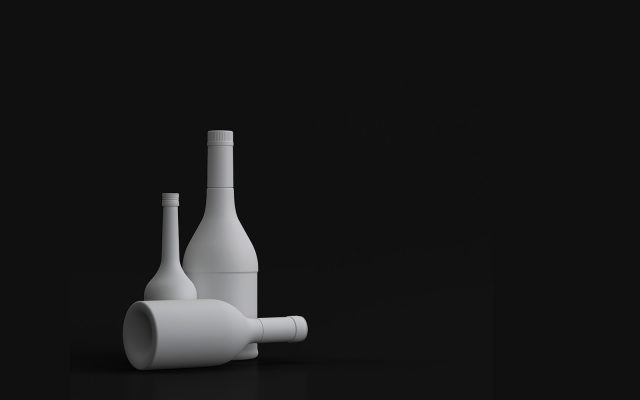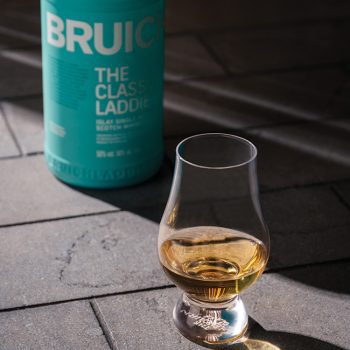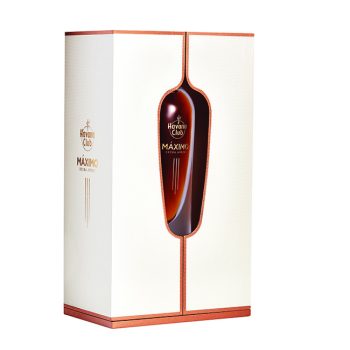This website uses cookies so that we can provide you with the best user experience possible. Cookie information is stored in your browser and performs functions such as recognising you when you return to our website and helping our team to understand which sections of the website you find most interesting and useful.
How can luxury spirits be sustainable?
By Kate MalczewskiWhisky producers are taking bold steps to reduce their environmental footprint, with a particular focus on eliminating secondary packaging. But can luxury and sustainability go hand in hand?

*This feature was originally published in the October 2023 issue of The Spirits Business magazine.
In July, Islay distiller Bruichladdich introduced new packaging for its flagship single malt, The Classic Laddie. The overhaul was undertaken with a focus on sustainability, and the revamped bottle showcases how producers can reduce their environmental footprint through both major and seemingly minor design choices. It now contains 60% recycled glass and is 32% lighter than its previous iteration. Its signature aqua hue comes from an organic ink coating, and its closure and cork are made of polypropylene, produced from bio-based sources.
 But one of the most significant aspects of the redesign isn’t a new feature, but rather what it’s missing: unlike its predecessor, the new-look Classic Laddie comes without a tin. Without secondary packaging, the new bottle has cut the Scotch whisky maker’s CO2 emissions by 65% – the equivalent of taking 182 cars off the road on Islay.
But one of the most significant aspects of the redesign isn’t a new feature, but rather what it’s missing: unlike its predecessor, the new-look Classic Laddie comes without a tin. Without secondary packaging, the new bottle has cut the Scotch whisky maker’s CO2 emissions by 65% – the equivalent of taking 182 cars off the road on Islay.
“You can’t justify secondary packaging anymore. There’s really no need for it,” says Lynne McEwan, global marketing manager at Bruichladdich. “There are 13 million cases of single malt whisky sold each year. Imagine removing the secondary packaging from that. It would make a big difference.”
Think outside the box
With this impact in mind, spirits producers are increasingly prioritising the eradication of secondary packaging in their wider roadmaps for sustainability. For instance, Pernod Ricard’s Irish Distillers arm has revealed plans to eliminate gift boxes from its Jameson, Powers, Spot and Knappogue Castle whiskeys by the end of 2025; it has committed to recycling, reusing or removing secondary packaging across its whiskey portfolio in the same timeframe.
“We understand that reducing our impact at all stages of our value chain is critical, and this includes packaging waste such as cardboard and choosing more sustainable packaging materials,” says Nodjame Fouad, Irish Distillers’ chief executive.
Diageo, too, has launched a programme to remove 183 million cardboard gift boxes across its premium Scotch offering, encompassing the Johnnie Walker, Buchanan’s and Bell’s brands, as part of its Society 2030 sustainability scheme.
“Since rollout, we’ve had a positive response from consumers and customers who agree with us that our gift and luxury is the liquid in the bottle, not the box,” a Diageo spokesperson tells The Spirits Business. “We’re constantly looking at the steps we can take to achieve our Society 2030 goals, and we’re exploring other categories where we can remove unnecessary packaging.”
Meanwhile, Bruichladdich owner Rémy Cointreau has set ambitious targets around secondary packaging for its entire portfolio, aiming for 85% of its bottles sold ‘naked’ by 2025. The company is currently at 78% – up from just 20% four years ago.
Earlier this year, it did away with gift boxes for its St-Rémy VSOP-quality brandy and changed its bottle to a lightweight recycled PET plastic; its Champagne Telmont brand is sold without a box as well. And The Classic Laddie’s redesign is just one element of the French firm’s secondary packaging plans for its Scotch whisky stable. In 2021, Bruichladdich launched its One Tin Lighter campaign, which made gift packaging optional on its website; it has since removed the option to choose a secondary tin for most bottlings. Future releases in the producer’s Barley Exploration range will stop using secondary packaging, and Port Charlotte’s whiskies, also made at Bruichladdich Distillery, went tin-free last year.
Shifting perspectives
However, getting rid of secondary packaging on a broader scale comes with significant challenges. For decades, producers have used boxes, tins and tubes to signal quality and gift-worthiness. Many consumers have come to view these elements as indicators of a more premium expression. Will people want to buy a luxury spirit that doesn’t have the traditional trappings of luxury?
“Some of the countries around the world will take longer to come on board with us,” Bruichladdich’s McEwan says. Psychologically, it is quite a big leap, because the perception is that Scotch single malt whisky should be in secondary packaging. It is going to take time. I think consumers are probably ahead in some countries. They’re looking for brands to come up with alternative solutions.”
Laetitia Delaye-Beineix, head of corporate and social environmental responsibility at Rémy Cointreau, echoes the idea that attitudes are shifting.
“A couple of years ago, luxury was more gold, more secondary packaging, more weight. All these codes have been evolving, and I think that the expectations of consumers are changing,” she explains.
“They are expecting us to come up with more environmentally friendly products.”
Market intelligence confirms Delaye-Beineix’s statement. According to the 2023 Buying Green Report from Trivium Packaging and Euromonitor International, 79% of consumers look for products in sustainable packaging, and 63% claim they are less likely to buy products with packaging that is harmful to the environment.
But many spirits enthusiasts still rely on traditional markers of quality. It’s up to producers to reshape the definition of luxury in environmentally conscious terms.
“Our role as a company is to promote more responsible and sober luxury – more authentic, more sustainable and more timeless. Secondary packaging is the tip of the iceberg,” Delaye-Beineix says.
Rémy Cointreau’s first step to appealing to consumers across demographics is communication. “It’s very important to explain the bigger context of these actions,” Delaye-Beineix adds. She points to Bruichladdich’s One Tin Lighter campaign, which “explained to the consumer the environmental benefits of buying the bottle without the tin that goes with it”, as an example, and notes that some Rémy Cointreau products display sustainability information directly on the bottle.
McEwan also underscores the importance of consumer awareness: “Education is the key, and the wonderful thing about single malt whisky drinkers is their love of education. They love the differences between distilleries and the way we all bring our whiskies to life. They’re up for education and, in many ways, they are ahead of us. They hold us to a higher standard. Let’s not let them down.”
She suggests that “tiny, subtle design points” can signal modern luxury, too – everything from the bottle’s colour, to its fonts and embossing. “Luxury should be in the detail,” she says. “It shows that we’ve put consideration into the bottle, the way it looks, the way it feels. All of these things together say that we’re going to show up in a way that feels desirable.”
Sustainable swaps
Still, the movement to remove secondary packaging entirely is in its early stages, with many producers instead choosing to explore environmentally friendly alternatives that keep up the traditional appeal.
“As an industry, we need to focus on how secondary packaging can be more sustainable, perhaps as opposed to eradicating it altogether,” says Scott Davidson, new product development director at Glencairn Crystal. “The drinks category is competing with other luxury items and has to be attractive enough to be considered a good premium gifting option.”
In this vein, Patrón Tequila owner Bacardí has pledged to remove all single-use plastic from its gifting range by the end of this year. Since December 2022, all new gift packs in the firm’s portfolio have been plastic-free. The company also trialled the use of a compostable material made from potato starch and cellulose fibres to replace the plastic vacuum packaging in its Aberfeldy 12 Year Old Gold Bar pack.
Rémy Cointreau has introduced cellulose packaging as well. Its Louis XIII Cognac comes in a recyclable coffret made of the material; at Bruichladdich, a forthcoming 18-year-old release will have secondary packaging in the form of a paper-pulp mould that fits onto the bottle itself – an industry first, McEwan says.
She emphasises that, while the vast majority of Bruichladdich products will be free from secondary packaging, this mould serves a functional purpose for spirits over £100 – “something that’s not your everyday drinking dram”. “It’s just to give the liquid that protection if it’s staying around for a lot longer,” she explains.
For its part, Beam Suntory-owned Scotch whisky Laphroaig recently switched its secondary packaging tube to a recyclable carton, along with swapping the bottle’s plastic top for one made from beech wood. These changes cut the Islay-based brand’s carbon emissions by a reported 30%.
Independent Scotch maker Nc’nean packages its organic whiskies in recyclable cardboard tubes, which are optional when customers order online.

And Pernod Ricard has supplemented its efforts to eradicate secondary packaging from its Irish Distillers portfolio with a new presentation for its luxury rum expression, Havana Club Máximo Extra Añejo. The brand opted for a gift box made from wood by-products, reducing its plastic components by 89% – a move that is “acknowledging our responsibility to deliver the more recyclable, sustainable packaging consumers call for,” according to Anne Martin, global marketing director for Havana Club.
Many spirits producers are now on the path to removing secondary packaging, but McEwan hopes the industry doesn’t linger too long in the transition. “Let’s just go for it. If we do it together, it will be much quicker,” she says. “The solution shouldn’t be to the competitive advantage of one company over the other. We need to do what’s right, and then help consumers come with us and give them things that are still super desirable.”
What does ‘luxury’ mean to your brand?
Louis Goddard-Watts – co-founder and CEO, Sly Dog Rum
“Luxury to Sly Dog is not only the creation of a product of exceptional quality, but also one that encompasses the expertise of our master distillers and memorable experiences. Our premium rum showcases the craftsmanship of using world-leading traditional distillation methods, master distillers and a refined ageing process to create a product that is unrivalled in the category. By using all-natural ingredients and ageing our rum in ex-Bourbon barrels, we have created an experience for consumers into the world of rum through a product that is exceptional and distinct.”
Chris Egger – co-founder, Portofino Dry Gin
“For Portofino Dry Gin, ‘luxury’ means more than extravagance. It’s about blending tradition, authenticity and craftsmanship. Luxury for us is like taking a journey to the beautiful Italian Riviera with every sip, guided by a rich history and 21 Mediterranean botanicals. It’s about quality, respect for our environment and for our heritage. It connects with people who love the finer things in life. In simple terms, Portofino Dry Gin sees luxury as an unforgettable experience that goes beyond the everyday and captures the spirit of la dolce vita – the sweet life.”
María L. Sanchez A – marketing coordinator for international business, Ron Carúpano
“In Venezuela and around the world Ron Carúpano is the signature for premium rum. Nowadays, moments and stories matter. In this sense, when we talk about luxury rums it is important to first recognize the story behind each one of them and their consumption occasion, that is why we have created seven SKUs within our commercial and Prestige collection. For our Brand occasion is king. We would like our consumers to know there is a Ron Carúpano product for every occasion, from a dinner with friends to a party or celebration. We have a variant perfect for each occasion. We can take people on a journey of discovery. From standard to ultra-premium rums, we have a different product for each stage of life ultra-premium rums, we have a different product for each stage of life.”

